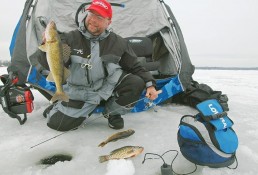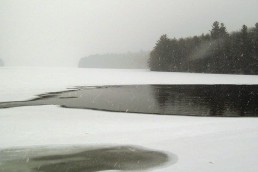Prepare for Next Winter’s Ice Fishing Now
SHARE THIS POST
When it comes to being the poster boy of organization, I must admit, I’m about as far away from perfect as anyone can be. With that said, now let me state that one of the most overlooked aspects of being a successful angler, no matter the season, is being organized and prepared well before any trip.
For me, early spring is my window of opportunity to sort out more than just my thoughts after a busy season of ice fishing and seminar engagements. It’s this time of year, winter is melding into spring—when the ice has deteriorated so much that safe travel is no longer an option. However, it’s too soon to launch my Lund since shelf ice still hampers the boat ramps. Thus, it’s when I put away my ice-fishing equipment properly so that I can easily manage it the minute I need it when first ice appears next winter.
Never really ‘put it away’
By far, I have found the best way to organize for next year’s ice-fishing season is to put my equipment away today as if I were going to use it tomorrow. That is, in a manner that it will ready to go at a moment’s notice.
The first thing I do is take everything out of my Otter portable shanty and erect the unit out of the elements. Once upright, I go over every square inch of the shanty to make sure nothing was broken. If any part of the cover, frame or sled is damaged, this is the time of year to get repairs made.
If all is in working order, I’ll rinse any dirt off with water, and if need be, include a mild detergent for stubborn stains. If soap is used, however, I make sure to rinse it off completely, since dust will cling to the residue and soak into and stain the shell, even when the unit’s in storage.
Once doused, I then keep the shanty erected for several hours to make sure it’s totally dry. Once arid, before folding it up, I spray a silicone lubricant on all moving parts of the frame, tow bar and zippers to keep them from seizing during inactivity.
All the while my Otter is airing, I will have had my Plano tackle totes open and doing the same. However, I allow them to stay arid longer, at least overnight. Unbeknownst to most anglers, condensation due to extreme temperature transitions will collect in unopened tackle totes this time of year and hooks will rust. Overall, all it takes is a thorough airing out to remedy this.
If I open my Plano tote and find my hooks already have a light layer of corrosion on them, I’ll simply wipe them off with a clean towel. However, if the rust has been on the hooks long enough to start pitting them—which in turn weakens the steel—I’ll replace them with razor-sharp Daiichi hooks.
If there is rust residue within my Plano tackle totes, they can be wiped clean with a damp cloth. However, if rust stains have infiltrated into the microscopic pores of the plastic, I’ll replace them rather than clean them with a rust-removing solvent. This is because the scent from the chemical will eventually penetrate into the lures, and the smell will repel fish the next time I use them.
The stripper
The next thing I do is prep my rods and reels for storage. If not done correctly, it may render them useless next season.
First, I take the reels off the rods, especially if I’ve used any kind of tape to hold them in place. Summer’s heat will react with the sticky substance of the tape and it will embed into cork or foam and ruin it.
If my Abu Garcia reels were filled with Trilene monofilament or Berkley 100% Fluorocarbon line, I’ll strip it from their spools. First off, you need fresh line on them next season, anyways. Second, mono and fluoro will expand when they get hot, which can easily damage a spool. If the spool is filled with Berkley FireLine, however, I’ll strip off a few feet and check for nicks or frays and remove it if any are detected.
Are you enjoying this post?
You can be among the first to get the latest info on where to go, what to use and how to use it!
This is also a good time to oil and grease my reels, and then wipe off the past season’s fish slime and minnow scales. I also make sure to loosen the drag knob to the point it nearly falls off to ward off damage to the washers of the drag mechanism.
I also clean to my ice rods, as well; paying special attention to their cork handles. A mere sprits of mild cleaner/de-greaser, such as Simple Green, will help remove the body oils that transferred from my hands, as well any fish slime. I also make sure to remove all cleaner residue off the rod handles, too, so as not to attract grime while they are in storage.
And when putting rods to bed for the season, I make sure the blanks are perfectly strait during storage. Whether fiberglass or graphite, the blanks can get a memory to them, and if stored bent they’ll stay that way forever after.
The best way I have found to store my ice rods is in an Otter Rod/Sportsman’s Case. I make sure it, too, is totally dry before locking its clasps. The case is foam-lined and protects my ice rods from damage, whether on the ice or stored in my garage.
Powerful thoughts
There’s no doubting a battery’s life will be extended if it is always kept at full charge. Power augers, too, will last for years without needing a major tune-up when they are put away properly.
Before I store my Lowrance Elite-5 IceMachine, I make sure its 12-volt battery is fully charged. (Actually, I do this after every use.) Once charged, I unplug the unit’s wires from the battery and check for corrosion. I also remove the Navionics mapping SD card from the unit’s reader so that I can use it in one of my two Lowrance units in my Lund.
Once ready, I store the unit in a place where I can easily get to it, so as to connect the charger during the mid-summer months to give the battery a boost.
When it comes to my underwater viewing system, I also makes sure its battery is at full charge, however, don’t tuck it away because I’ll be using it throughout the open-water season, as well.
As for my gas-powered auger, I empty out the majority of the gas, however, I leave a little with a dash of fresh fuel stabilizer. I then run the unit, allowing the additive-mixed gas to run through the system so as to keep the internal gaskets from drying out.
Preparations are always in order
To be ready for first ice next winter, I put my ice-fishing gear away today as if I were going to use it tomorrow. Shanty: dried out and lubricated. Tackle: aired out and hooks replaced. Reels: Stripped of line and lubed. Rods: tape off, wiped off and stored strait. Batteries: Charged. Power auger: gas stabilized and/or unit tuned-up.
Mark Martin is a veteran walleye tournament pro, and runs Ice-Fishing Vacation/School in Michigan. He’s in the National Fresh Water Fishing Hall of Fame and won the first PWT Walleye Trail Championship in 1990. For more information on Mark and the school, check out markmartins.net.
MWO
SHARE THIS POST
Did you enjoy this post?
You can be among the first to get the latest info on where to go, what to use and how to use it!
Mark Martin
Mark Martin is a professional walleye tournament angler and instructor with the Ice Fishing School/Vacation series. For more information, check out his website at markmartins.net or fishingvacationschool.com.



